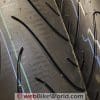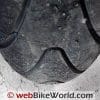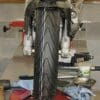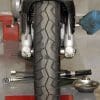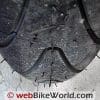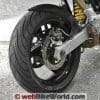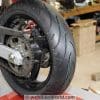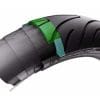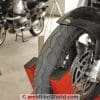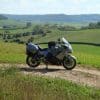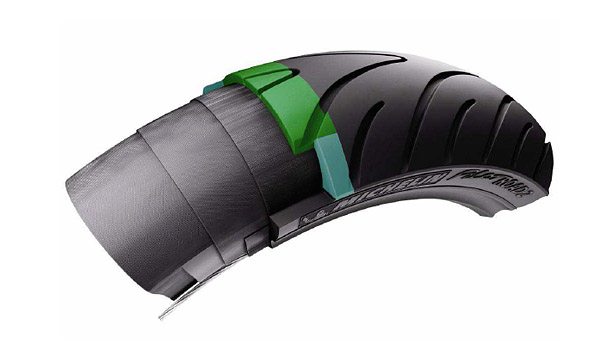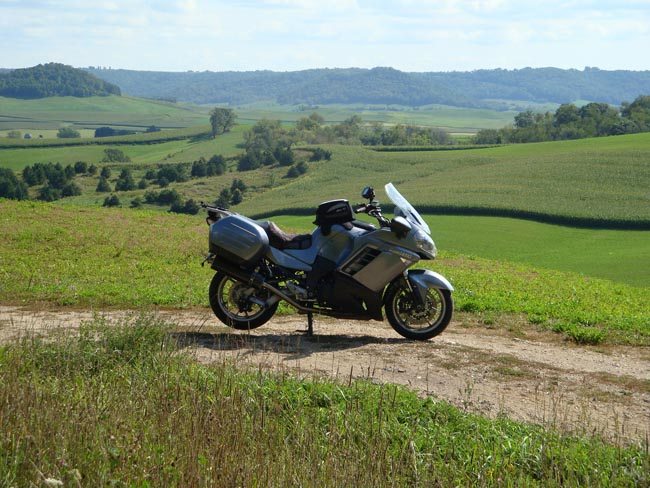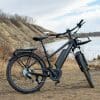Tires for the Multistrada already?
The bike has only 1,500 miles on the clock, but I haven’t been very fond of the Pirelli Diablo tires that were fitted at the factory, and I wanted to try something new and different for the benefit of our readers.
UPDATE: The Pirellis are/were apparently called simply “Diablo”, not “Diablo Corsa”; see comments section below).
It’s nearly impossible to conduct an objective evaluation of motorcycle tires — or any tires for that matter.
That’s why published tire comparison reviews are very rare.
There are too many variables and it is extremely difficult to get the kind of repeatability necessary to objectively evaluate tire performance in a meaningful way.
Sure, it can be done, but only under controlled conditions, where the environment and testing procedures are “scientific” and repeatable.
This means that consumers have to assume the tire manufacturer’s data — if any is provided — is accurate and useful.
Instead, what we’re typically faced with is some narrative spun out by the marketing department in the form of a press release, which naturally claims that Acme’s new RoadBlaster Grab-n-Go tires are, no doubt about it, the greatest thing since carbon black.
Notice I used the word “objective”.
There are plenty of subjective motorcycle tire reviews around — they’re known as opinions, and you’re reading one right now. But true objective testing, with real data on grip levels, wear and temperature charts? Very rare indeed.
So all I can do is provide a subjective opinion for the Michelin Pilot Road 2 tires recently fitted to the Multistrada.
Since this is an opinion from one rider about a specific tire on a specific motorcycle, my findings may vary considerably from other Pilot Road 2 owners using the tires on the same or other motorcycles.
But since webBikeWorld readers typically have a voracious appetite for information, and since our mission is to help our readers make informed purchasing decisions, I think this narrative will indeed be useful.
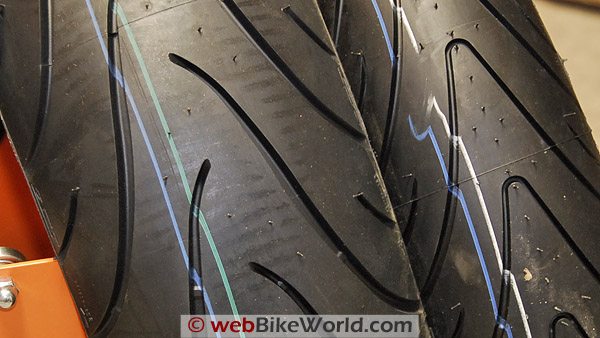
What Tires?
The Multistrada 620 came with the original version of the Pirelli Diablo tires. Pirelli now has another version, called the Diablo Corsa III, that may indeed be different from the version described here.
I noticed right away that the Pirellis felt like they had a “hard” compound.
Apparently, Ducati’s primary goal was to outfit the bike with a decent set of relatively inexpensive tires designed for basic riding and for long wear; nothing wrong with that, actually.
It also seemed to me that the tires took an exceptionally long time to warm up, but I have no real data to back this up.
I would describe it like feeling that I had to tiptoe around on the bike for the first few miles of every ride — longer than what I consider to be normal — until the tires offered decent grip.
But even then, I never felt 100% comfortable that the tires were providing all of the grip that the bike could handle.
The combination of the basic suspension on the Multistrada 620 and the “hard” Pirelli Diablo tires also gave the Multi a feeling that I would describe as slightly “jumpy” or “jittery” or “nervous”.
Not to an extreme, but the Multi didn’t feel as solid and secure as I thought it should or could.
Now I might not have noticed any of this if it weren’t for the GT1000 that I could compare it to.
Which, even though it also doesn’t have the world’s most sophisticated suspension, felt “smoother” and “silkier” and definitely more “solid and planted” than the Multi, especially in the turns and especially when the pavement was less than perfect.
The Diablos also seemed to have a profile that was slightly too “sharp”; in other words, the turn-in felt too sudden, and the bike moved around a bit more than I’d like, especially in slightly bumpy conditions in turns.
It certainly wasn’t as rock-steady as the GT1000 with its understeering-but-lovable Michelin Pilot Classic tires.
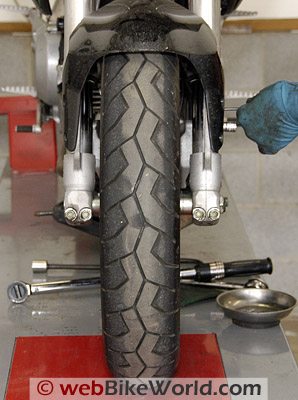
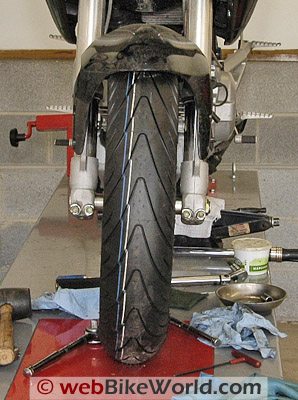
Michelin Pilot Road 2 Tires
I described this in the Multistrada Blog not long ago, and after some research, I was considering spooning on a set of Metzeler Sportec M-1 tires. But one thing led to another, and I ended up with the Pilot Road 2’s.
My logic went something like this:
I have a great deal of respect for Michelin products (especially after my experience with the Pilot Classics on the GT1000), and I could source a set of Michelins easier than the Metzelers.
And the Pilot Road 2 is a pretty new tire, and it’s claimed to have dual-compound MotoGP technology, and I wasn’t able to find many owner opinions about the tire, so I thought webBikeWorlders would be interested in learning more.
As good a reason as any to try a new tire, no? So a set of Pilot Road 2’s it was.
The Mulitstradino takes a relatively standard sized 120/60-17 front but a slightly narrower than normal 160/60-17 rear. The front was $133.46 and the rear was $166.30 through our friends at RevZilla.
Motorcycle tires are always way more expensive and wear out much quicker than I think they should, but three’s nothing we can do about it, unfortunately.
I have no idea whether the price we paid is the lowest for these tires.
But they were available and ready to ship, and RevZilla also carried the set of Avon Storms for Chris’ FJR1300 that we wanted (which we’ll feature in an upcoming article), thus is was more convenient to place the single order.
A few hours with the No-Mar Motorcycle Tire Changer (review), the Handy Motorcycle Lift (review)and the very nice Tachyon motorcycle tire balancer (review) and the deed was done.
Of course, these quality tools made the job about ten times easier than it could be, but to be honest, there’s not much to swapping out a set of tires on the Multistrada 620.
We had no experience removing the tires on this particular bike, but it was a simple matter of loosening the rear axle nuts and chain tensioner, pulling out the axle and removing the rear tire (with the bike held up by a jack under the engine, of course).
Removing the front wheel is, interestingly enough, very similar to the process for removing the front wheel of the old BMW R65; loosen the two pinch bolts on either side, loosen the axle nut on the left-hand side, pull out the axle and you’re done.
The Tachyon balancer is a joy to use, and the Michelins, as expected, didn’t need much weight to balance (although we should have checked the balance of the wheels without the tires first, which would have provided a more accurate indication of the balance of the tires alone).
We got them to within a couple of grams (less than 1/8 of an ounce), which is good enough in my book.
I’m not as fussy about tire tread patterns as others, but I will say that the Michelin Pilot Road 2 pattern looks more modern and aggressive than the Pirelli Diablos.
I have come to the (unsupported by fact) conclusion that tread patterns must be more for show than go, because you would think that by now the manufacturers would have discovered a particular tread pattern that provided optimum performance.
But since every tread pattern I’ve ever seen on both motorcycles and cars is different, I can only conclude that it doesn’t make much difference.
Although I’m sure the manufacturers would disagree, as their new and fancy tread pattern is the most visible distinguishing characteristic of the tire that makes their tire different — and better — than the rest. Right?
Michelin Pilot Road 2 Motorcycle Tires: Ri ding Impressions
My feeling is that it takes at least 1,000 miles to really develop a good understanding of a new set of motorcycle tires and how they perform after they’re fully broken in and under a variety of conditions and heat cycles.
So I’ll add my impressions to this list as I get more experience with the Michelins.
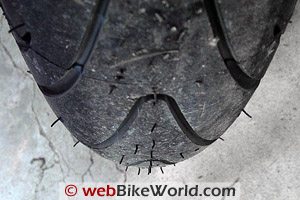
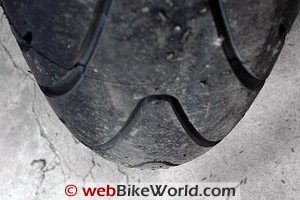
Riding Impressions: 0-100 Miles
Motorcycle tires must be broken in very carefully, and the first 100 miles is critical (see this note in the Comments section below).
There are many scary stories about slippery mold release residue causing loss of traction and a resulting crash when the tires are new.
I have a friend who, after getting a new set of tires fitted, dumped the bike while pulling out of the driveway of the repair shop, so I’m pretty wary about this problem.
I usually scrub the tire surface down with a wire brush and/or a piece of Scotchbrite or heavy-grit sandpaper before the first ride.
Some owners even wash the tires first with soap and water or they wipe the tires with a grease remover prior to giving them the wire brush treatment.
I don’t know if washing or scrubbing actually does, in fact, remove the mold release agent, but I guess it gives me some psychological benefit.
In any case, when I ride on a new set of tires, I’m extremely cautious for the first couple of hundred miles.
New tires typically have many sprue nubs that stick out like a week-old beard; they’re an artifact of the tire mold.
These little nubs are hardened sticks of molten rubber that are left over from the molten rubber that escapes into the sprue to prevent air bubbles and to promote more uniform distribution of the rubber over the tire carcass in the mold.
I don’t know whether the nubs can affect traction, but I usually pluck them from the tires. I didn’t take the time to remove them from the Michelins before the first ride; as a result, I swear I could feel them squirming under the tires as I rode.
My seat-of-the-pants impressions during the first hundred miles are this: Unlike some other tire swaps I’ve experienced, I don’t notice a dramatic difference — yet — with the Pilot Road 2’s compared to the original Pirelli Diablo tires on the Multistrada 620.
It’s definitely too early to tell, but I think the bike feels slightly more “planted” in a straight line and that the tires are slightly more compliant and not as “hard” feeling as the Pirellis.
The Michelin tires, I think, may offer a slightly plusher ride, but I do feel a touch of “squirm” or a slight “greasiness” even while riding upright.
I have also noticed that on the initial transition to lean, the tires also feel like they’re squirming slightly, which may be due to their newness, or to the many sprue nubs, or the mold release, or, most likely, to a combination of all three.
I do not remember feeling this “greasy” or “squirmy” feeling on initial turn-in with any other motorcycle tires I’ve tried, so I’m concerned but hopeful that this feeling will disappear as the tires get scrubbed in.
At this point, because the tires are so new, I haven’t come anywhere close to leaning the bike to anything more than very shallow beginning rider angles.
But once past that squirminess that I feel on the initial turn-in, the tires do then give a feeling like they’re providing good grip levels and more compliance than the Pirellis.
This may be due to the softer section of the dual-compound tread that Michelin says makes up the sides of the tires.
Again, this is all very preliminary, and, as often happens, I’m hyper-sensitive to tire feel at this stage of the game, due to both my nervousness about new tires and the mold release problem and to my desire to compare the tires as quickly as possible to the Pirellis while they’re still fresh in my mind.
So, the bottom line for my 0-100 mile impression is that the Michelin Pilot Road 2 tires so far seem to provide three different types of feedback:
Slightly more compliance or plushness when upright, albeit with what feels like some squirm and softness; a slightly unsettling feeling during the initial turn-in, where the tires feel slightly “greasy”; and the potential for good feel and control and grip when the bike is leaned over.
I’m hoping and anticipating that this will change dramatically — for the better — as the tires get scrubbed in, so stay tuned.
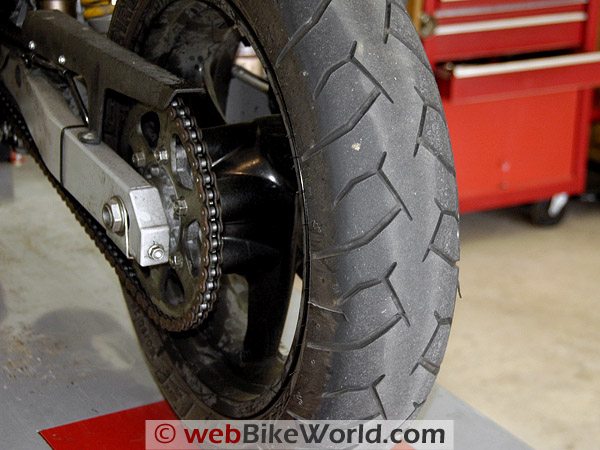
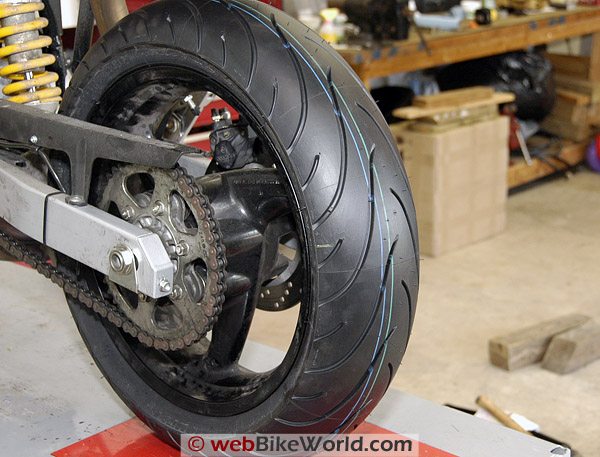
Riding Impressions: 100-250 Miles
I removed the sprue nubs from the tires; the front tire had many of them right along the centerline of the tire.
This immediately seemed to stop the “squirm” I was feeling. Again, this is all very subjective, but my impressions so far aren’t much different than I reported below from the first hundred miles.
I don’t get a sense that the new Michelins are a dramatic improvement from the original Pirellis. They do some things better and some things not as well as the original Pirelli Diablos.
Many owners replace an old set of tires and report a huge difference, but let’s face it — replace an old worn tire with a new one of pretty much any brand or type and chances are the bike is going to feel dramatically better.
In this case, the original tires had only 1,507 miles, so the differences in feel between the two brands of tires are much more subtle.
I believe the Pilot Road 2’s have a more rounded profile than the original Pirellis.
The original tires made the bike feel like it needed more effort to initiate the turn-in; the Michelins make the bike feel like it can roll back and forth more smoothly, without any sort of “step” off the centerline.
I also think the Pilot Road 2 tires feel slightly more compliant and they do feel “stickier” than the original Pirellis.
The Multistrada does feel slightly more confident when leaned over, and one thing I can say with certainty is that the new tires allow me to make minute adjustments when the bike is leaned over in a turn, so I am able to place the bike where I want to with more precision.
Where before the bike felt a bit nervous in a turn, and I had to take a set and stick with it, the Michelins allow me to make path adjustments and they accept this with no problem and the bike remains steady.
This may be due to the softer dual-compound rubber on the sides that Michelin touts as one of the benefits of the Pilot Road 2 tires.
However, I still feel that on this particular bike, the Pilot Road 2 tires provide slightly less “feel” for the road.
The Michelins still feel slightly “rubbery” to me and I keep getting this feeling like I’m isolated a bit too much from what’s going on with the tires — almost like there’s too much compliance.
The original Pirellis felt “hard”, as I reported, but one of the benefits of “hard” was that they did give me good feedback for the road surface.
This “rubbery” feeling is difficult to describe actually, and I’ll wait until I have several hundred more miles to really understand the differences.
I don’t think what I’m experiencing is tread squirm, because the Michelin Pilot Road 2 tread pattern doesn’t really have any tread blocks that could move around.
So the bottom line so far is that I’m pleased, but not overwhelmed, with the results. I seem to be getting the compliance and reduction in nervousness I wanted, with a bonus of added precision when leaned over, but the tradeoff seems to be that the tires don’t provide the direct feel for the road that I had before.
At this point, if you asked me if I’d buy the Michelins again if I had to do it over, I’d probably say no. But we’ll see what the next few hundred miles bring…
Riding Impressions: 250+ Miles
A strange thing happened on the way to 300 miles! As I’ve reported below, the Michelin Pilot Road 2 tires just didn’t seem to be providing the grip and confidence I expected. Then it all suddenly came together a couple of days ago…
The weather had finally warmed up to the nice and sunny 70-degrees that it should be in late May. I was riding around, just enjoying the day, and ended up turning on to an old paved back country road I had nearly forgotten.
As soon as made the turn, I discovered that the roads maintenance crew had, for some reason, decided to cover the entire paved road with a layer of “bluestone”.
This is a small sharp stone used in the mixture with asphalt, and sometimes laid down on a soft tar road to create a quick and cheap surface, but this is the first time I’ve seen it used on what used to be a slightly rough but serviceable paved road.
The road was completely covered with the stuff. Perhaps they thought the stones would work their way into the pavement somehow during the hot summer?
This is not a well-traveled road, and serves only a couple of farms and remote homes, so it’s not like there will be a lot of traffic working the stones into the pavement.
I had to take it easy on the bike, because the surface was very loose — like riding on sand. I eased up on my death grip and let the bike go more or less where it wanted — fortunately, there were no other cars coming or going.
This lasted for about 3 miles, believe it or not — 3 miles of curvy, hilly loose stone on top of hard pavement. I had a couple of interesting moments, but I just took it easy and came through without a problem.
Now what happened afterwards may be a complete coincidence, or I may be dreaming, but here’s what happened:
The road finally ended and I turned on to clean pavement, and after about a half-mile or so when the dust finally blew off the tires, the “greasy” feeling of the Michelins that I reported below was gone. The tires all of a sudden seemed to grip like I had hoped and expected they would!
Then as the tires warmed up again and all of the dust and dirt from that back road finally disappeared, the tires definitely felt like they came into their own — like they had finally become “broken in”.
The rest of the ride was amazing — the bike now feels very confident and controlled in the corners, and I can lean the Multistrada way, way over.
And that is a looong way when you’re sitting upright on that tall bike!
It also feels like there’s and enormous amount of grip and confidence and controllability that was never there before, either with the Michelins or certainly with the old Pirellis.
I have since mentioned my experience to a couple of local very experienced long-distance riders who live nearby, and they agreed that it’s not uncommon for some brands or a particular manufacturing lot of new tires to take several hundred miles to really “come into their own”.
Apparently, my initial impression that this particular set of Michelin Pilot Road 2 tires felt “greasy” was, in fact, due to the mold release.
That’s possibly because of the cool and damp spring weather I experienced just after they were installed, which took much more time to wear away than might be expected.
The abrasion caused by riding 3 miles or so on the loose and sharp gravel over the paved road, along with the stone dust (which is also used to absorb oil spills), was, I think, key in removing the last of the mold release, allowing the rubber to finally take over and do its thing.
So now allow me please to completely change my opinion about the Michelin Pilot Road 2 tires! They have indeed transformed the handling on the Multistrada 620, giving it the confidence and smoothness and control that I desired and expected.
One moral to this story then is that motorcycle tire mold release is a curios thing — be extra careful when you install a new set of tires. And maybe try to find a nice gravelly road to scuff in the tires? 😉
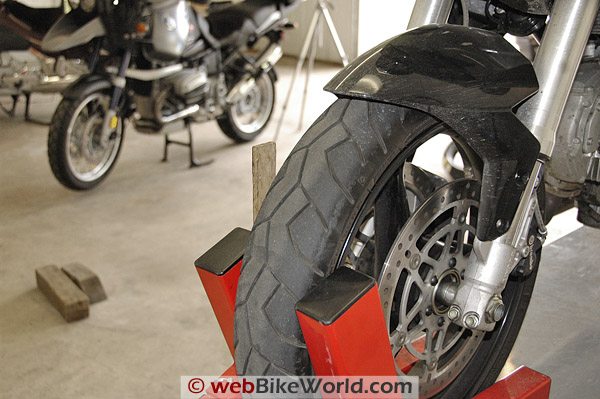
Riding Impressions Conclusion
If you have any experience with these tires you’d like to share, or if you have some insight on motorcycle tires or tips for tire break-in, please send it to us at and I’ll add it to the comments below.
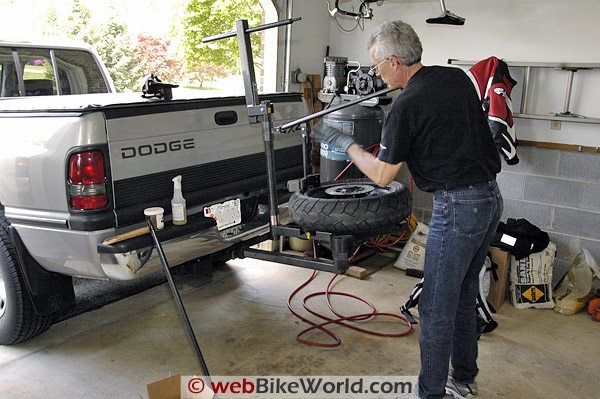
Michelin Pilot Road 2 Details and Specifications
According to Michelin,the Pilot Road 2 was intended to create a sport touring tire that maximized wear while providing optimum grip.
Michelin says they used their “2CT” (Two-Compound Technology), developed in MotoGP, to combine different types of rubber on the tread to optimize performance in each specific zone.
Michelin claims that “this technology provides excellent traction on wet roads owing to the soft rubber on the shoulders and less wear at the tread center where the rubber is more resistant.
As a result, the new Michelin Pilot Road 2 combines qualities that were previously thought to be mutually exclusive. Its excellent grip on wet roads ensures a safe ride while its remarkable wear-resistance offers unprecedented longevity.”
Michelin organized a test of the Pilot Road 2 tires, which was conducted by CERM (Centre d’Essais Routiers Mécaniques)in 2006.
They claim that the test demonstrated that the Michelin Pilot Road 2 effectively combines the two qualities (CERM is an independent organization that conducts tests and surveys for the automobile and motorcycle industries).
The Michelin Pilot Road 2 was tested against six competing brands and, according to Michelin, the Michelin Pilot Road 2 outperformed the other tires in wet grip and wear resistance.
The Suzuki Bandit 1200 motorcycles fitted with Michelin Pilot Road 2 tires “scored the fastest times on a wet track and demonstrated superior longevity to the other tires” (size 120/70 ZR 17 front and 180/55 ZR 17 rear).
Michelin says that the Michelin Pilot Road 2 “combines soft rubber shoulders with a hard rubber tread center”, and that they offer “all the advantages and none of the disadvantages of each rubber type in terms of grip and long-life wear-resistance”.
Their press release for the tires claims that “The softer rubber compound on the shoulders delivers better grip and quick tire warm-up. The more resistant compound on the tread center offers greater longevity.
The tread center rubber mix was developed to guarantee high mechanical resistance, not just for longevity, but also for traction and effective braking.” ·
Michelin also says that the 2CT technology “ensures even wear across the tread, even in demanding conditions. The Michelin Pilot Road 2 uses three new silica-reinforced tread compounds. Developed from MotoGP rain tires, the silica component guarantees safety and progressive responsiveness on cold, wet surfaces.
The different rubber compounds used in the tread were positioned to achieve maximum tire performance. The front tires integrate a soft rubber compound, while the rear tires are made with a harder compound that can withstand greater demands during acceleration.”
The rear tires “also have a relatively softer section, part of which is in contact with the ground even when the vehicle is fully upright. This facilitates warm-up and, consequently, grip,
The Michelin Pilot Road 2 is said to be “a combination between the tire’s predecessor, the Michelin Pilot Road, and the sportier Michelin Pilot Power.
The front tire has a sporty new profile to enhance GT motorcycle handling and guarantee livelier performance, offering both greater responsiveness and optimum stability for leaning and cornering.
The new tread pattern on the Michelin Pilot Road 2 was developed for two purposes: to evacuate water effectively and avoid dangerous forms of wear.”
Publication Date: May 2008
More wBW: Michelin Pilot Road 3 Review | Motorcycle Tire Reviews
Owner Comments and Feedback
See details on submitting comments.
From “T.W.” (February 2012): “Motorcycle 2008 Kawasaki Concours 1400. Usage: two sets of Pilot Road 2’s and current set of Pilot Road 3’s.
First off these tires changed the handling of the C-14 dramatically.
Eased the turning so much they felt like they caused 100+ lbs. to disappear from the “bulky” Concours. Serious lean angles are obtainable and sustainable.
Taken two major tours, lots of commuting and back road strafing in southwest Wisconsin.
They held up very well mileage wise, especially considering the loads, two weeks ‘o gear, trunk mounted etc. Now running Pilot Road 3’s with more siping.
Toured the East Coast 2011, National Concours Rally in Vermont. Rode through a torrential downpour for 20 minutes coming home. The wet traction bordered on freakish. Actually rolled the gas on, and braked fairly hard (ABS) and the tires would not break loose.
Expensive? Yes. Worth it? Every penny. As a tire guru at BIR once said: “Spend the money on rubber now or on plastic and plaster later”.
Some C-14 owners were posting the Pilot Road 3’s felt a tad loose compared to the 2’s due to the additional sipes. Personally I found there stick as well as the 2’s and even seem to wear better.
The north central Concours Owners Group had a weekend ride in southwest Wisconsin last October. I was pushing the front end and had the back spinning up a bit on the C-14, a big girl to be trying that with but it felt just right. (I love chasing down sport bikes with a bagger 😉
For reference I have the secondary injector plates removed (they rob the bottom end) a power commander and a mellow Area P slip on installed. I can’t imagine running any other street tire. Thanks again for the great site!”
From “D.G.” (July 2011): “Interesting review to me particularly since I came off of riding Pirelli Diablo tires. Of note, I had the Pirelli Diablo “T” tires that came standard on my 09′ Buell Lightning. They look different than the ones on your bike.
The Diablo actually had numerous variations, and Pirelli did a poor job at differentiating the differences. However the Diablo “T” is the most amazing tire on the planet!!! It is just one half step under a full out track tire.
The grip was insane as I could scape my peg around corners with insane confidence that no other tire could inspire. So I think you had the cheapo version of the Diablo.
Also I just put a pair of Michelin Pilot Road 2 on my bike, cant say how they are yet I have less than 100 miles, but they do NOT inspire confidence, I am hoping to get some mileage out of them though, because my Diablo “T” back tire was gone after 4K miles, but what a ride.
Editor’s Reply: Pirelli has exploited the “Diablo” name to the point that it is now used on so many different tires that it’s now too hard to tell which tire is which, so the term is basically meaningless.
Thus, it’s not a surprise that one version of the “Diablo” branded tire can be dramatically different than another. They probably put the cheapest “Diablo” on the Multistrada 620 to save money…
From “D.W.” (03/11): “Just stumbled onto your Pilot Road 2 review, and thought I would mention my experience.
I have a BMW K1200R that came from the first owner with nearly track tires (Conti’s?) that were incredible for the 2k it took me to scrub off the last half of the tread.
After reading the i-bmw forums I decided on the Pilot Road 2’s since they have a rear tire for heavier bikes. Almost 10k later I am getting ready to replace, but these tires have met any reasonable expectation I could have.
They track true, have great traction and forgiving recovery when slid, great wet traction, and good road feel. I hear the Pilot Road 3’s are out, but honestly can’t think of how they will be an improvement. Here’s to MotoGP and technology trickle-down!”
From “S.C.” (5/10): “Thanks for an interesting article. I’ll share my experiences if I may.
I ride a BMW R1200ST here in Australia. I don’t ride in wet weather unless I get caught in it. I do, however, do some quite fast touring (up to a steady 140 kph speeds) and go for the occasional 600 km days in the countryside with friends.
I am not afraid to take dirt roads, in fact quite like them. I give the tyres as much twisty work to do as I can because (being a cheapskate) I like to wear them out evenly to get as much dollar value as I can.
I am just now due for replacements. I will see almost 16,000 kms (10,000 miles) from this set. They are worn to within 1/4” of the sides because they inspire confidence even on my Telelever suspended bike which some think can feel a little disconnected from the road.
I must add though that the handling began to feel “funny” around the 13,500 kms mark.
I wondered if it was me getting old, or the bike needing some suspension adjustment or if it was because I had the panniers on and full of luggage but since I was on a mountainous three day 1600 km trip I didn’t examine the problem in detail.
I did think, however, about how the handling characteristics had changed.
The bike seemed slower to turn in initially but then fell in quickly. I found that disconcerting, especially in the tight turns where slower speeds made a quicker fall-in feel all the more dramatic.
When I came home I checked everything meticulously and found the front tyre in particular had worn the soft side compound flat so that the tyre profile had changed from round to more of a Vee, which is OK for changing direction fast on my R6 but not ideally suited to touring on something substantially heavier.
Of course, the extra grip which gives me confidence to ride to the edge of the tyre was also the reason the sides wore to a different shape. It makes complete sense.
There has to be a trade-off for the grip. I could have changed them at 13,500 kms to avoid this but stoically got another 2,000 kms before getting to the wear indicators.
But do I like them. Yes, very confidence inspiring, especially after I figured out that near the end of their life they were telling me something totally logical.
So, be confident that smooth riders will get good mileage from these tyres, but remember that those last few thousand kms will feel different in the twisties. I hope this information is useful to other readers.”
From “W.K.” (5/10): “Just wanted to give my feedback on these tires as I have about 10,000 miles (16,000kms) on my current set which unfortunately need to be replaced.
Overall, the tires have been fabulous. They have done what they have claimed to do by sticking in the corners and providing a stable, long, smooth ride on the highways.
I have my Michelin’s mounted on a 2007 Bandit 1250 ABS (120/70 front and 180/55 rear). I have ridden the bike in all kinds of weather and the tires have never failed me.
I was especially impressed with their rain characteristics. I came home late last year on some “less than ideal” highways in a pouring rainstorm.
On a few occasions I had to open the Bandit up in order to avoid a “situation” and the tires stayed planted, never giving any indication of loss of traction.
I have read about a few people commented on squirming and have experienced this on only a few occasions. It was always in high cross winds.
I do not believe this is the tires issue as I have driven countless miles/kilometres on freshly ground highway (you know the checkered grinding pattern they use prior to re-surfacing that makes your bike feel like its shaking its rear end) where the tire, if it was going to squirm would have.
But it didn’t it stayed perfectly straight and gave no indication of squirming.
As for wear, the tire for the most part has worn evenly.
The noticeable flat spot simply is not there but I have noticed that in the last 1000 miles the tire has become noticeable worn. Up to the 9000 mile mark it was like the tires was not wearing at all. I really can’t complain, these have been the best tires I have had so far in my 30 years of riding.
That said, tire technology has come so far in the last number of years that it is hard to find a bad tire. Some wear faster than others but overall we as a motorcycle community are very lucky with what is available. I look forward to see what’s next. So bottom line, would I but these again….absolutely.”
From “H.C.” (2/10): “I ride a Suzuki GSR600 (a ‘tamed’ GSXR 600 with an upright riding position, for you in the US) to work and back every day. 40 Kilometres in each direction.
The weather in the part of South Africa where I live, can vary significantly within the course of a day in any given season. You can ride to work in the blazing heat and sunshine and 40 degrees Celsius, only to have a cold, rain-soaked ride home.
On top of that, there is currently a major roadworks programme ongoing to improve the freeways that I use daily.
I have just fitted a set of Michelin Pilot Road2’s, after first wearing out the OEM Bridgestone BT014’s (9000km) [Wicked good tires – grip like chewing gum, but prone to ‘tracking’ linear road imperfections] then a set of Bridgestone BT57’s (another 9000 km) [Better straight-line stability, but no confidence leaning over].
I should maybe admit that I am a fairly timid rider – no ‘sissy stripes’, but I do make a set of tires last pretty long.
My options at purchase where these or a set of Pirelli Diablo Strada’s for about the same price. From the reviews I’ve found, I am expecting even better mileage on these tires.
At present, I can only echo your comments on the first 1 to 100 miles on your set of these tires. Mine feel exactly the same at 50 kilometres – squirming and not holding a straight line under acceleration.
These front tire feels very nervous and skittish (“greasy”) accelerating hard and straight at this stage.
There is no problem with leaning them over – they track true and certainly feel pliant and grippy through the corners.
I hope the nervousness in the front end in a straight line goes away very soon. Two things currently bug me about these tires: (a) does anyone have the correct pressures to run them at and (b) why is the front made in Spain and the rear made in Thailand?
Editor’s Reply: Michelin has manufacturing plants in various locations around the world, but one would hope and trust that with the reputation of Michelin that it wouldn’t matter where the tires are made.
I know it took some time for the set described in the review above to feel comfortable and secure, so hopefully yours will too.
Regarding pressures, I would use the tire pressures recommended in the owner’s manual unless you hear different from Michelin. I do often experiment very slightly with tire pressures, but only in the range of 5% or so (e.g., 1.5 to 2.0 PSI in a tire that takes 30 PSI).
From “S.W.” (4/09): “After trying a set of Conti Road Attack tires on my 2002 Bandit 1200S and going through them in about 5,000 miles (I commute 40 miles/day plus weekend rides in the mountains), I decided to try the Pilot Road 2s.
I currently have about 8,000 miles on them after 14 months.
They have more than met my expectations with great handling and grip in both dry and wet as well as excellent wear.
Even as the center wears due the commuting I don’t get the falling over feeling when leaning over that I got with other tires when transitioning from the wearing center to the less worn edges.
I’ll be putting on another set when these wear out. Even thought initial cost is more they are less expensive in the long run.”
From “B” (9/08): “I am about to swap to my second set of Pilot Road 2’s. Quite frankly, they are the best value for money tyre I have ever ridden on.
I ride a BlackBird (lots of twisty roads, long distance rides, constant stop/starts in traffic) and I have to date done nearly 14,000 kms on them.
The only reason I am swapping them now is due to a long distance trip coming up shortly, but I suspect there is still another 1500kms left in this set. If anyone is looking for a tyre that gives excellent road grip and durability, I can absolutely recommend them.”
From “R.P.” (7/08): “On August 18th of last year, I became the proud of a 2008 Concours bike with ABS brakes.
Standard tires for my bike were Bridgestone’s 021 series. While their factory tires seemed adequate, my real world experience was less than complementary.
Specifically, Bridgestone’s tires would “track” every road irregularity it came in contact with.
As for cornering grip, I also experienced some “slippage” on asphalt painted services. High speed stability proved to to be the tires best trait while low speed speed handling left much to be desired.
Prior to your Michelin Pilot Road 2 tire review, I had compiled weeks of research on ALL available tires for my bike be it Sport or Sport Touring tires. In the final analysis, it came to Avon’s Storm or Michelin Pilot Road 2 tires~~~~~Drum roll please~~~
I went with Michelin’s Pilot Road 2 tires. I purchased my tires from a local shop as I was intent on getting new tires with a “date of birth in the 2008 year. With my tires mounted and balanced, off I went.
From the moment of driving off, my bike had been transformed. Everything the 021 tires lacked, the Road 2’s had in Spades. In my entire life, I have never experienced any tires that had make such a positive change.
Perhaps the best way I can describe the feeling is to say that the bike just floated. Counter steering became almost non- existent as just moving my body off center was all I needed to initiate a turn.
Comfortable, quiet, and confidence assuring I pursued my nemeses of the grooved highway in Hal Moon Bay, (California).
Just prior to reaching that point, my mind was reeling as to what (if any) difference I might experience in my bikes stability. After all, things were going too good at this point.
Time had come. I entered the grooved roadway expecting some sort of a “twitch”, but there was nothing! I kept asking myself, “How can it be that someone can make a tire with such positive results? I still don’t know.
After following Michelin’s tire break in procedure, I rode with my Very experienced neighbor on Sunday morning of that same week. David still has 3 bikes and has been riding for many years.
Simply put, David led and I followed his “spirited” pace through the twisty mountain roads. Within a short time, our sojourn had become the most aggressive ride I have ever encountered. As for my new Michelin tires, they were nothing less than completely confidence inspiring.
How well the Pilot Road 2’s will handle in the wet or how long they will last, I haven’t a clue . How Michelin’s tires work with my specific bike is simply not believable to me.
As for any negatives, I haven’t found any yet but I’ll keep looking for them! ”
From “A.B.”: “Coming back to bike riding after a hiatus, I found the tyre market quite disappointing, and thought that having a one compound for sports touring tyres was pointless, and wished that tyres had a harder centre and a softer edge.
Obviously I hadn’t been reading much in the way of MotoGP tyre technology.
Because I started to get greater lean angles as I got more familiar with cornering, I started discovering the “no confidence zone” in the mediocre tyres that I was buying
Then one day I read a fabulous article in the Two Wheels magazine regarding Michelin’s “2CT” Pilot Road 2, having used the original “Road” I thought the new concept was exactly what I was looking for.
And after reading the write-up I was suitably impressed to go out and replace the worn rear tyre with this new fandangle Michelin 2CT.
Well I’m happy to say that now I’m on my second rear PR 2CT, I’ve never had so much confidence in a tyre, it wears round even in touring type conditions where never-ending twisties are not guaranteed.
They last better than my previous choice ST tyres and behave exceptionally well in the wet, in the corners and right up to the point of leveled wear (bars) indicators. BTW I’ve also tried the new Dunlop RoadSmart,…….I’m staying with the Pilot Road 2.
You mention some funny behaviour on the 620 MTS, I took a loaner with the same Pirellis, I’ve got to say that bike is not as planted as it’s bigger brother let alone my ST4S.
And I’ve seen people who did not like the Pilot Power on their bikes, as these have a sportier profile they lose a little stability of the round profile, and conversely the round profile loses the accuracy to the sporty profile. These could be the preference of different riders and different choices.”
From “D.R.”: “I appreciate your comments about tire reviews in general as to their objectivity being nearly impossible to obtain. Well said. Secondly, you mention your OEM tires as being Pirelli Diablos.
However, clearly pictured in your photos are Pirelli Diablo Stradas, a sport touring type of tire that I would expect to find on a Multistrada or sport touring bike.
As for your maniacal procedure for prepping a new tire; washing, wire brushing and plucking the nubs to alleviate a feared presence of a mold release agent, I think you have spent entirely too much time reading forums.
Everyone knows to take it easy until you scrub in a tire (ON THE ROAD).
But to even mention a procedure such that you describe is truly laughable. And you certainly don’t need 100 miles to properly scrub in a tire. Sure 100 miles is a good rule of thumb, but hardly necessary.”
Editor’s Reply: Most motorcycle manufacturers recommend a (minimum) 100 mile break-in period, see:
- Maxxis (recommends 100 miles)
- Michelin (recommends 50 km)
- Dunlop (recommends 100 miles)
- Metzeler (recommends 100-200 km)
The 5 minutes or so that we spend with a wire brush and Scotchbrite pad may or may not do anything, but it gives some peace of mind and it does seem to help.
Also, the original tires on the Multistrada were not the Pirelli Diablo Strada, they were the Pirelli Diablo type. Here are photos of the Pirelli Diablos:
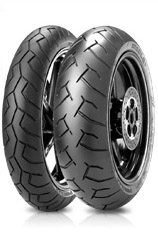


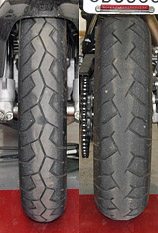


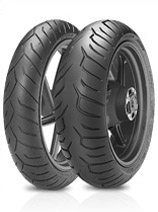


From “M.S.”: “This tire came stock on my 08 Yamaha FZ1. WOW, they feel solid!
They fell better every time I am on my FZ, I feel secure on the turns, stopping, and running over small road trash. Comparing cost to other comparable tires (Metzler), I would fork out the difference to get another set of MPR2’s.
As always, keep up the great work. Your reviews are right on; I base some of my purchases and further research on products based on your site. Keep it dirty side down!!!!”
From “N.W.”: “I recently replaced the OEM Pirelli Diablo front tyre on my Guzzi Breva 750 with a Michelin Pilot, at about 13000 miles.
The OEM rear Pirelli wore out after about 5500 miles, the Metzeler I replaced it with after about 5000, for the last 1500 or so I’ve had a Michelin Pilot Activ on the rear. T
he difference with Michelins front and back was dramatic, right from the word go – the bike feels much steadier, handles much more predictably, and doesn’t skitter about even on bumpy surfaces.
I agree with P.G. (comment below): confidence is what these tyres give you; they may even forgive me if I get over-confident (not that I intend to test that!).
Now all I hope is that the rear lasts a bit longer than the others did …”
From “M.W.”: “I have used three of these tyres now on the rear of my CBR 1000. I found the std Road was good on the VFR, but not quite adequate for the CBR, & the Power wore out too fast.
The 2CT is just right for me, more than enough grip for my level of riding, even when I’m on a well known road I’ve never had a moment, & more kilometres than the PPs.
The centre does wear first but that is the nature of our roads here in West Australia.
I always take it careful for the first 100 km on any new tyre, increasing the lean angle a little at a time, but I have complete trust in them and by the time they are worn out there is only about 10mm on the outer edges not touched.
I will try a 2CT on the front next time as I have been using the stickier Pilot power for a while, which seems a good combination.”
From “K.D.”: “I have a Multi (albeit a 1000) and have had Pilot Road 2’s on there for about 500 miles now. I think they are a great tire. I even put a short fire road ride of about 40 miles on there last weekend and they did OK in that environment also.
I had Pilot Powers on before that and put about 6000 miles on those, but the rear center wore out before the front so I thought I’d try the dual compound PR2s as my next set.
The front profile of the PR2 seems to fit the bike well, with it’s wide handlebars you don’t need the triangular profile of a more track oriented tire to initiate turn in.
The PPs always felt strange to me on the mid-speed corners where I felt like I was riding on the transition point between the flat sides of the tire and the more pointed middle. I don’t feel that on the PR2s.
The PPs did rail pretty good on the faster turns where you are fully onto the side but the PR2s seem OK to me as well.
This is the complete opposite to my previous bike, an ST4S, where the narrow handlebars and heavier bike needed the track type tire to make the bike turn quickly. I had both Metzler Z6s and Pirelli Corsa IIIs on that bike, the latter being my preferred.”
From “P.G.”: “I just read your article on the Michelin Road 2 tires. I recently also changed the tires on my bike (2001 Yamaha XJR 1300) from Pirelli Diablo’s (don’t know what type exactly) to Michelin Pilot Road 2’s.
I didn’t bother with removing the hairs from the tires or washing/scrubbing them before the first ride, but I did ride out very, very carefully. Nevertheless, I could not believe the huge difference these tires make compared to the old ones!
After the first few 100 kilometers, I now go flatter and faster through corners than ever before with the Pirelli’s. These tires just give loads of confidence.
I don’t recall any squirming, even during the first few kilometers.
Also I should mention that my Pirelli’s were not new when I got the bike, and worn by the time I decided to switch them (the rear wheel even locked up on me once on a mildly damp road when I had shifted down and released the clutch).”


